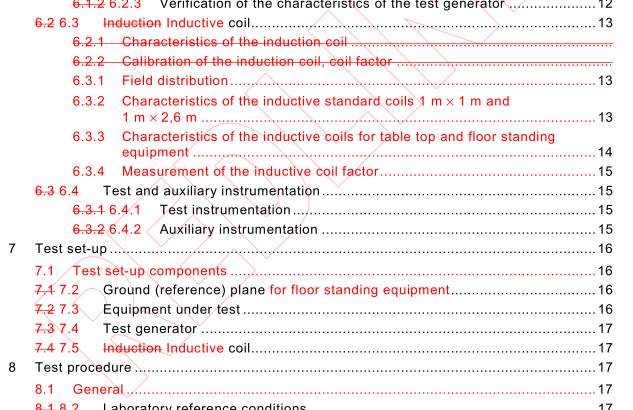IEC 61000-4-8:2009 pdf download – Electromagnetic compatibility (EMC) – Part 4-8: Testing and measurement techniques – Power frequency magnetic field immunity test
3.8 decoupling network, back filter electrical circuit intended to avoid reciprocal influence with other equipment not submitted to the magnetic field immunity test
3 4 General The magnetic fields to which equipment is subjected may influence the reliable operation of equipment and systems. The following tests are intended to demonstrate the immunity of equipment when subjected to power frequency magnetic fields related to the specific location and installation condition of the equipment (e.g. proximity of equipment to the disturbance source). The power frequency magnetic field is generated by power frequency current in conductors or, more seldom, from other devices (e.g. Ieakage of transformers) in the proximity of equipment. As for the influence of nearby conductors, one should differentiate between:
– the current under normal operating conditions, which produces a steady magnetic field, with a comparatively small magnitude;
– the current under fault conditions which can produce comparatively high magnetic fields but of short duration, until the protection devices operate (a few milliseconds with fuses, a few seconds for protection relays). The test with a steady magnetic field may apply to all types of equipment intended for public or industrial low voltage distribution networks or for electrical plants.
The test with a short duration magnetic field related to fault conditions, requires test levels that differ from those for steady-state conditions; the highest values apply mainly to equipment to be installed in exposed places of electrical plants. The test field waveform is that of power frequency. In many cases (household areas, sub-stations and power plant under normal conditions), the magnetic field produced by harmonics is negligible. However, in very special cases like heavy industrial areas (large power convertors, etc.) they occur, and will be considered in a future revision of this standard.
5 Test levels
The preferential range of test levels, respectively for continuous and short duration application of the magnetic field, applicable to distribution networks at 50 Hz and 60 Hz, is given in Table 1 and Table 2. The magnetic field strength is expressed in A/m; 1 A/m corresponds to a free space induction magnetic flux density of 1 ,26 μT.
Information on the selection of the test levels is given in Annex C.
Information on actual levels is given in Annex D.
6 Test equipment
6.1 General
The test magnetic field is obtained by a current flowing in an induction inductive coil; the application of the test field to the EUT is by the immersion method.
An example of application of the immersion method is given in Figure 1 .
The test equipment includes the current source (test generator), the induction inductive coil and auxiliary test instrumentation, that are also given in Figure 3.
6.2.1 Current source The current source typically consists of a voltage regulator (connected to the mains distribution network, or other sources), a current transformer and a circuit for the control of short duration application. The generator shall be able to operate in continuous mode or short duration mode. The connection between the current transformer and the inductive coil input should be as short as possible to avoid that the currents which flow in the connection produce magnetic fields that affect the magnetic field in the test volume. Preferably the cables should be twisted together. The characteristics and performances of the current source or test generator for the different fields and for different inductive coils considered in this standard, are given in 6.2.2.
6.2.3 Verification of the characteristics of the test generator
In order to compare the results for different test generators, the essential characteristics of the output current parameters in the standard inductive coils shall be verified.IEC 61000-4-8 pdf download.
